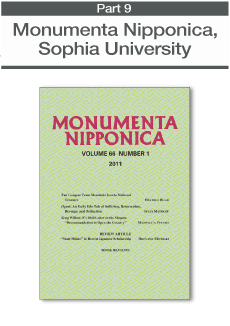|
 |
Junko Shinohara
(Sophia University Monumenta Nipponica)  |

| Name of society: |
Monumenta Nipponica, Sophia University
http://www.sophia.ac.jp/eng/e_top |
| Founded: |
1938 |
| Membership: |
|
| Journal titles: |
Monumenta Nipponica |
| Field: |
Japanese studies |
Platforms used:
|
• Project MUSE® • JSTOR |
| URLs: |
[ Project MUSE® ] http://muse.jhu.edu/
[ JSTOR ] http://www.jstor.org/ |
| E-journal specifications: |
PDF files |
| Electronic submissions system: |
Currently in transition from postal to electronic submission |
| Copyright policy: |
Monumenta Nipponica, Sophia University |
|
Project MUSE®
The Project MUSE® electronic journal collection is a service to provide access to the full text of scholarly journals—currently more than 400 titles—mainly in humanities and social sciences from around the world. Launched in 1993 as a joint project of the Johns Hopkins University Press and the Milton S. Eisenhower Library at the JHU, Project MUSE® has been providing electronic journals since 1995 thanks to grants from the Andrew W. Mellon Foundation and the National Endowment for the Humanities. From 2000 onward, it has been operating in its current form with the cooperation of various other university and scholarly publishers from around the world. Project Muse® subscriptions are limited to research institutions such as universities.
|
Measures Needed to Further Improve the Journals
- First published in 1938, Monumenta Nipponica initially carried articles written not only in English but also in German and other European languages. From 1964 onward, however, English has been the sole language of publication.Recognized internationally as an important scholary resource on Japanese studies, Monumenta Nipponica is one of the journals invited to join the JSTOR online archive from an early stage along with Harvard Journal of Asiatic Studies (Harvard University Press) and The Journal of Asian Studies (Cambridge University Press).
As Monumenta Nipponica celebrated its 70th anniversary in 2008, we were reminded of its founding purpose of serving as a common platform for scholars from both the East and West to share their views and exchange scholarly findings with one another. In order to enhance the content of the journal in line with this purpose, we think it is important to increase the number of articles written by Japanese and other Asia-based scholars. Because Monumenta Nipponica is published in English, the majority of submissions are from scholars in North America and Europe. A major factor making it difficult to publish articles written by Japanese scholars is the significant time and cost involved in translation. In this fiscal year, we received a grant for translation from the Tokyo Club, which has already enabled us to publish a review essay written by a Japanese scholar in Vol. 66, No. 1. The remaining budget will be used to translate another article by a Japanese scholar. Presently, no budget is set aside for translation at Monumenta Nipponica. Therefore, we believe that we will need to continue to apply for grants to continue this translation initiative in the future.
E-journal Sales Promotion to University Libraries
- At the moment we are not involved in advertising efforts to market the journal to libraries since articles published more than five years ago are available through JSTOR and those published thereafter—including those in the latest edition—can be accessed through Project MUSE®.
Promotion to Authors to Further Increase Submissions
- The editor of Monumenta Nipponica attends at least two international scholarly conferences in Asian and Japanese studies annually and encourages scholars to submit articles to the journal. In addition, members of the Advisory Board, and associate editors are also encouraging submissions to the journal through their networks.
|
|

